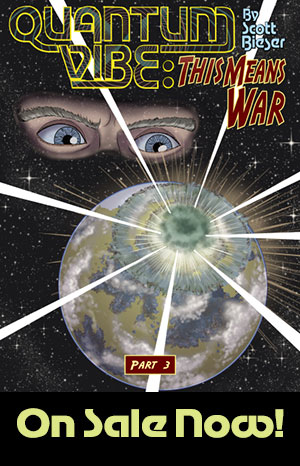Strip 2028 - Click strip above to goto the next strip.
First Seen: Mon 2019-12-02
Story & Art: Scott Bieser - Sci-Fi Adventure Monday & Thursday.
Dark plans fall like thunderbolts.
Quantum Vibe
A thousand years in the future, humanity has colonized worlds in nearly 100 galaxies, thanks to Quantum Vibremonic technologies developed five centuries earlier. Other new technologies have created various off-shoots of humanity and extended life expectancies five-fold. The story begins with how a mad scientist and his plucky assistant, along with their robot friend, brought humanity to the stars, and continues with the adventures of some unique people in fantastic places.
One Dollar Sale Continues! [ Jun 24, 2025 ]

Hard to believe it, but Big Head Press published it's first novel, over 20 years ago. To commemorate our stubborn longevity, we continue to stubbornly offer each of our non serialized graphic novel stories for just one mere American dollar (plus shipping). Start your holiday shopping early and light up some body's mind with one or more of these titles.
Offer only available in the United States.
Transcript For Strip 2028
Panel 1A large, long, dark asteroid is barely visible against the stellar background. Some speed lines to indicate it's moving along its length, in ¾ aspect to foreground-right
Caption: In the year 568 SA, the invention of the Oresme-Murphy Discontinuous Displacement Engine made instantaneous travel between distant locations, even across millions of light-years, not only possible, but common-place.
Caption: As one result, technology enabling swift travel through real space-time languished.
Panel 2
The asteroid is now seen in side-view. We can see a bit of machinery on the back end of it.
Caption: Gravity drives only work well in the vicinity of large masses. Solar sails only work well near bright stars.
Caption: Fusion and ion drives are limited by the amount and weight of the fuel they can carry. More fuel means more mass means more fuel required to achieve a desired rate of acceleration.
Panel 3
The asteroid is now moving away.
Caption: For such practical reasons, the fastest spacecraft rarely exceed one-tenth of light-speed – roughly 30,000 kilometers per second.
Caption: And achieving that speed requires 3 Standard days of acceleration at more than 10 times the gravity of Old Terra. Across 4.5 billion kilometers.
Panel 4
The asteroid is farther away now.
Caption: However, if one wants to accelerate a large mass up to a large fraction of light-speed, within a reasonable time-frame, the Displacement Engine does offer part of a solution.
Caption: But using it does require some patience. Plus, a willingness to risk oblivion.
Web-comics Scott Reads
SPACETRAWLERGrrl Power
Schlock Mercenary
Unsounded
Diesel Sweeties
Girl Genius
XKCD
Drive
Day By Day
Saturday Morning Breakfast Cereal
Questionable Content
Gunnerkrigg Court
Something * Positive
Oglaf (NSFW)
Trekker
HELM
POWERNAP
For news and reviews:
The Beat
Bleeding Cool
Comics Worth Reading
Framing Graphics © 2024 Big Head Press


















